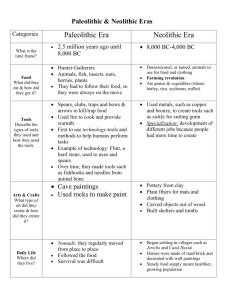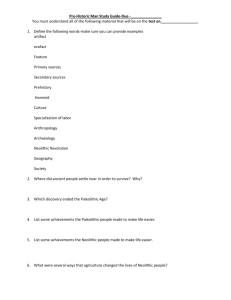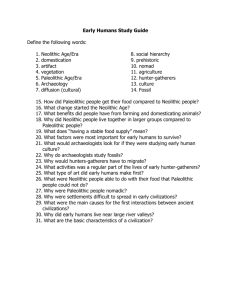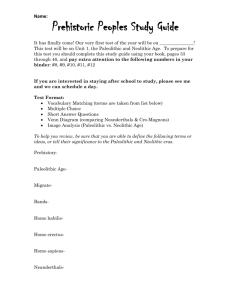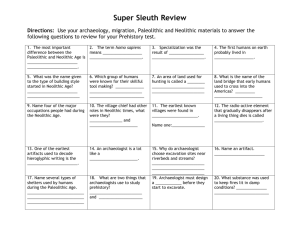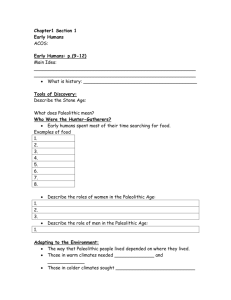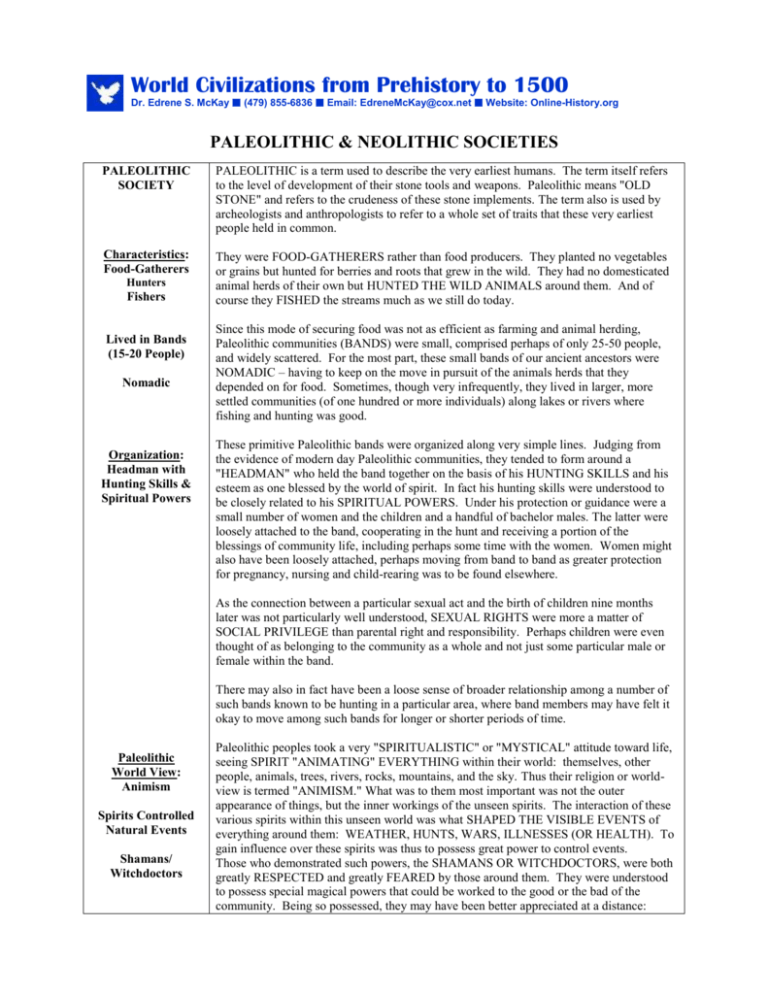
World Civilizations from Prehistory to 1500
Dr. Edrene S. McKay (479) 855-6836 Email: EdreneMcKay@cox.net Website: Online-History.org
PALEOLITHIC & NEOLITHIC SOCIETIES
PALEOLITHIC
SOCIETY
PALEOLITHIC is a term used to describe the very earliest humans. The term itself refers
to the level of development of their stone tools and weapons. Paleolithic means "OLD
STONE" and refers to the crudeness of these stone implements. The term also is used by
archeologists and anthropologists to refer to a whole set of traits that these very earliest
people held in common.
Characteristics:
Food-Gatherers
They were FOOD-GATHERERS rather than food producers. They planted no vegetables
or grains but hunted for berries and roots that grew in the wild. They had no domesticated
animal herds of their own but HUNTED THE WILD ANIMALS around them. And of
course they FISHED the streams much as we still do today.
Hunters
Fishers
Lived in Bands
(15-20 People)
Nomadic
Organization:
Headman with
Hunting Skills &
Spiritual Powers
Since this mode of securing food was not as efficient as farming and animal herding,
Paleolithic communities (BANDS) were small, comprised perhaps of only 25-50 people,
and widely scattered. For the most part, these small bands of our ancient ancestors were
NOMADIC – having to keep on the move in pursuit of the animals herds that they
depended on for food. Sometimes, though very infrequently, they lived in larger, more
settled communities (of one hundred or more individuals) along lakes or rivers where
fishing and hunting was good.
These primitive Paleolithic bands were organized along very simple lines. Judging from
the evidence of modern day Paleolithic communities, they tended to form around a
"HEADMAN" who held the band together on the basis of his HUNTING SKILLS and his
esteem as one blessed by the world of spirit. In fact his hunting skills were understood to
be closely related to his SPIRITUAL POWERS. Under his protection or guidance were a
small number of women and the children and a handful of bachelor males. The latter were
loosely attached to the band, cooperating in the hunt and receiving a portion of the
blessings of community life, including perhaps some time with the women. Women might
also have been loosely attached, perhaps moving from band to band as greater protection
for pregnancy, nursing and child-rearing was to be found elsewhere.
As the connection between a particular sexual act and the birth of children nine months
later was not particularly well understood, SEXUAL RIGHTS were more a matter of
SOCIAL PRIVILEGE than parental right and responsibility. Perhaps children were even
thought of as belonging to the community as a whole and not just some particular male or
female within the band.
There may also in fact have been a loose sense of broader relationship among a number of
such bands known to be hunting in a particular area, where band members may have felt it
okay to move among such bands for longer or shorter periods of time.
Paleolithic
World View:
Animism
Spirits Controlled
Natural Events
Shamans/
Witchdoctors
Paleolithic peoples took a very "SPIRITUALISTIC" or "MYSTICAL" attitude toward life,
seeing SPIRIT "ANIMATING" EVERYTHING within their world: themselves, other
people, animals, trees, rivers, rocks, mountains, and the sky. Thus their religion or worldview is termed "ANIMISM." What was to them most important was not the outer
appearance of things, but the inner workings of the unseen spirits. The interaction of these
various spirits within this unseen world was what SHAPED THE VISIBLE EVENTS of
everything around them: WEATHER, HUNTS, WARS, ILLNESSES (OR HEALTH). To
gain influence over these spirits was thus to possess great power to control events.
Those who demonstrated such powers, the SHAMANS OR WITCHDOCTORS, were both
greatly RESPECTED and greatly FEARED by those around them. They were understood
to possess special magical powers that could be worked to the good or the bad of the
community. Being so possessed, they may have been better appreciated at a distance:
Paleolithic and Neolithic Societies
Page 2
called on for their services by a particular band only under certain circumstances. These
individuals may in fact have considered a large region accommodating many different
bands as their spiritual territory, drifting in and out of the life of the various bands as the
occasion required.
Pre-Enactment
But the community as a whole felt that it exercised some CONTROLLING INFLUENCE
over events by their ability to “PRE-ENACT” the important events of their lives (what we
would today call VISUALIZATION). Thus the community engaged in ritualistic WAR
DANCES, HUNTING DANCES, RAIN DANCES, MEDICINE DANCES AND
RITUALS, etc. which supposedly had the power to predispose or control the behavior of
the unseen spirits in order to assure a forthcoming favorable outcome, whatever the event
or whatever the community's particular need.
Though this describes human life as it was lived hundreds of thousands of years ago, it
continued to persist as a lifestyle even up until a century or less ago among groups of
American Indians (North and South), Africans, Pacific Islanders, and Australian aborigines.
NEOLITHIC
SOCIETY
Characteristics:
Food-Producers
Agriculture
Animal Husbandry
"NEOLITHIC" describes the more expertly worked stone implements (thus "new stone")
which our ancient ancestors began to create about 10-12,000 years ago. But even more
importantly, the term refers to a new FOOD-PRODUCING CULTURE of FARMING and
ANIMAL HUSBANDRY--that is, raising your own crops and herds.
For reasons that are a mystery to us today, these ancient ancestors of ours began to sow
seed into the ground with the understanding that this would eventually produce mature
grasses (primitive forms of BARLEY AND WHEAT) whose grains they could reliably
harvest.
As wild grains were reaped rather freely in the areas where agriculture began to take place,
one could wonder why they would have undertaken such labor at all. It has been
speculated that the effort may have been minimal at first: perhaps merely scattering some
seed left over from a previous harvest in the wet alluvial mud that washed down from the
hills each spring.
In any case, it probably served as a very helpful, and at times vital, supplement to the
hunt. Also, grains had the added advantage that they did not have to be eaten immediately
but COULD BE STORED FOR PERIODS of time when food became scarce.
Agriculture also may have been useful in domesticating animals. During dry seasons, the
offering of a regular supply of grain for natural grazers such as wild goats, sheep or pigs,
may have enticed these sources of meat on the hoof to stick close to human communities.
Certainly we do know this: that agriculture and animal herding or "husbandry" seemed to
have pretty much grown up together.
Planning
Growth in
Population
Villages
Neolithic
World View:
Fertility Rites
Pre-Enactments
This in turn called forth PLANNING: the selection of the plumpest grains for storage as
seed grain for the next season's planting and the selection of the strongest animals in their
herds for mating in the next rutting season.
Finally, agriculture permitted the GROWTH OF THE HUMAN POPULATION and its
concentration into ever-larger VILLAGES and even AGRICULTURAL TOWNS.
Neolithic religion reflected the new interest in food production, for the Neolithic peoples
had learned the secret of reproducing food through controlled implantation of the seed into
the womb (whether the earth or a female animal). So too, Neolithic peoples typically
performed "PRE-ENACTMENTS" of the all-important agricultural or animal life cycles –
often in ways that are shocking to our more prudish sensitivities.
Reference here is to the seasonal performance of FERTILITY RITUALS involving the
Paleolithic and Neolithic Societies
Mating Rituals
Life Principal:
Sexual
Page 3
public "MATING" of a male member of the community ("CORN KING") with a female
representative of the "EARTH MOTHER." (Sometimes too the Corn King was
RITUALISTICALLY SLAUGHTERED at the beginning of the next planting season in
representation of the necessary dying and planting of the seed into the earth as the source of
the new season's crops.) Because of the importance of her function in the life of the
Neolithic agricultural community, Earth Mother was often the most important spirit or god
within the extensive religious pantheon of the community.
Thus the "LIFE PRINCIPAL" of Neolithic culture was essentially "SEXUAL" and the
manipulation of these religious insights in order to guarantee crops and herds involved the
periodic performance of what we consider shocking sexual fertility rites. Thus we think of
these ancient cultures as sexually "loose." Actually, the very sacredness of the sex act also
involved conformity of society's members to a very STRICT SEXUAL CODE regulating
human sexual relations (including often the intense cloistering of the female to protect her
from unregulated male sexual activity).
We now believe, in general, that settled agriculturalists tended to emphasize the FEMALE
PRINCIPLE OF LIFE: the earth or womb out of which their crops grew and life depended
on this rite as the true source of life. The male principal was viewed as a supportive or
secondary function. Indeed, the male symbol (the goddess' consort or "king" for a year) was
sometimes slaughtered and buried (planted as a seed) to ensure the success of the season's
plantings.
Agricultural:
Mother Earth
Nomadic:
Great Father
All agricultural peoples of the Ancient World worshipped some variant of the Great
Goddess or "EARTH MOTHER": Inana (Sumeria), Ishtar (Babylon) or Ashtarte (Syria),
Anat (Canaan), Isis (Egypt), Aphrodite (Greece).
But nomadic ANIMAL HERDERS or pastoralists, who moved around in the search of new
pasturing for their all-important flocks, were less attached to the womb of soil. They
tended to preserve greater reverence for the MALE PRINCIPLE. They were more focused
in their religious impulses on honoring the "GREAT FATHER" from whose seed the tribe
descended.
By their mutual calculation of descent from such a "Father" or common seed, the living
descendents of nomadic societies were able to reckon their social ties with each other,
family by family, clan by clan, tribe by tribe, ensuring some degree of peaceful and orderly
economic and political relations as they wandered from place to place.
This was characteristic of both the Aryan nomads (Hindus, Persians, Greeks, Celts) and the
Semitic nomads (Hebrew Israelites, Ishmaelites, Edomites, etc.) who moved their peoples
in and around the periphery of the more settled ancient Near East.
Adapted from A History of The World's Major Cultures by Miles Hodges
For more information on this topic, explore one or more of the following online resources:
ONLINE
RESOURSES
Walking with Cavemen: Don’t miss this one. It’s the website for the BBC television
program “Walking with Cavemen.” Watch humans evolve, find out what makes us human,
enter the cave and discover how Neanderthals lived 50,000 years ago.
The Long Foreground: Human Prehistory: An overview of human evolution, the hominid
species, and human physical characteristics (the latter is especially interesting)
Human Prehistory: An Exhibition: Pages on the first humans, their tools, artistic endeavors
and early settlements.
Paleolithic and Neolithic Societies
Page 4
Agricultural Revolution: Information on the process, problems and benefits of man settling
into agricultural villages. Deals with technological changes and domestication of plants and
animals.
Drawing on the resources you have had an opportunity to explore (textbook, course
documents, online resources, library resources), answer one or more of the following
questions:
DISCUSSION
QUESTIONS
What are the characteristics of Paleolithic societies and how do they differ from
Neolithic societies? How do they differ in world views?
What role did religion and magic play in primitive society?
How were cave art and ritual practices expressions of religion and magic?
What is known about gender roles during the Paleolithic and Neolithic Ages? Why did
early humans, and subsequent societies, divide labor by sex?
Why was the development of agriculture so crucial for the establishment of
civilization? What advantages do food producers have over food gatherers? What
disadvantages do they have?
What does the conservative nature of primitive society suggest about attitudes toward
progress, innovation, and change? How would primitive man fare in today's world?
What special insights have you gained from your exploration of Paleolithic and
Neolithic societies?

